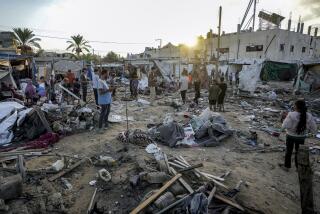Blue Helmets Heading for Gulf Border Duty : The glamour unit assigned to the Iraq-Kuwait frontier boasts a Nobel Prize for keeping peace in troubled places.
- Share via
WASHINGTON — The Blue Helmets, as everyone calls the United Nations’ peacekeeping forces, are not even mentioned in the U.N. Charter.
The late Dag Hammerskjold, secretary general in the 1960s, joked that they were authorized by “Chapter 6 1/2”--somewhere between Chapter 6, which deals with the peaceful settlement of disputes, and Chapter 7, which deals with aggression.
Yet, since the United Nations was founded in 1945, the Blue Helmets have become one of the organization’s most glamorous, effective units. They won the Nobel Peace Prize in 1988 in recognition of their work over the years.
When the deployment of 1,440 observers and soldiers on the Iraq-Kuwaiti border is completed April 19, it will be the 19th peacekeeping operation that the United Nations has mounted.
The first contingent of Blue Helmets arrived in Israel in 1948 to supervise the Arab-Israeli truce. That mission, pared to 291 observers, is still going, 43 years later.
Coming in the aftermath of the Persian Gulf War, the latest mission, commanded by Austrian Gen. Gunther Greindl, underscores a paradox: While the United Nations has been unable to prevent outbreaks of war since its founding, it has proved skillful in mopping up its remnants and preventing recurrences.
Deployment of the force is part of the strict cease-fire terms the United Nations set and Iraq accepted. U.N. troops, headquartered in the Iraqi town of Umm Qasr, will be charged with monitoring the withdrawal of U.S. and coalition troops, manning observation posts, mounting land and air patrols and policing cease-fire and border violations.
They likely also will get the task of ensuring that humanitarian aid reaches tens of thousands of Iraqi Shiite refugees who fear to return to areas controlled by President Saddam Hussein.
The U.N. force will operate in a demilitarized zone 75 miles long and 8 miles wide. Its contingent will include 300 observers, 680 infantry troops, 300 engineers to clear mines and 160 personnel to pilot and service planes.
Secretary General Javier Perez de Cuellar has not announced the nationalities of members of the force. But it is known that Austrians and Danes, now based in Cyprus, will be included.
The Blue Helmets are far different from the U.S.-led allied forces, sanctioned by the Security Council, that trounced Iraq. U.N. peacekeeping forces are only lightly armed, with orders to fire only in self-defense. They take orders directly from the United Nations, not from their military leaders at home.
The latest operation will push the United Nations further into debt. Perez de Cuellar, calling on U.N. members--already $1.5 billion behind in dues and peacekeeping contributions--to underwrite the operation, has estimated its cost at $123 million.
Largely due to the Reagan Administration’s antipathy toward the United Nations, the United States is by far the most glaring offender, owing $568 million in dues and $169 million for peacekeeping.
The Blue Helmets have usually been soldiers from small countries such as Fiji and Norway. The current force will include soldiers from 32 nations, including four of the so-called Big Five U.N. members--the United States, Britain, France and the Soviet Union.
By tradition, Iraq has the right to reject what it regards as objectionable nationalities on its soil; it has hinted it would object to troops from any country in the allied coalition.
Planning for the U.N. peacekeeping operation began before the war ended. Only hours before allied ground forces thrust into Kuwait and Iraq in early February, U.N. Undersecretary General Marrack Goulding, director of peacekeeping operations, was quietly at work putting together a possible force for the aftermath of war.
Goulding, 55, a former British diplomat who once served in Kuwait, asked U.N. envoys from more than 20 countries about their supplying officers or troops for peacekeeping. Some, such as Norway, accepted quickly.
In fact, ambassadors from Norway, Finland, Sweden, Denmark and Iceland had told Perez de Cuellar a month earlier that they would take part if needed.
KEEPING THE PEACE
The United Nations has 11,000 soldiers and observers from more than 40 countries acting as peacekeeping forces.
The U.N. divides these missions into two categories: observing and actual peacekeeping. Unarmed officers usually serve as observers, while officers and troops, lightly armed for self-defense, serve as peacekeepers.
Since 1948, half a million men and women have served in U.N. peacekeeping operations. There have been more than 700 deaths. The heaviest casualty areas have been the Congo (now known as Zaire), where 234 died from 1960 to 1964; southern Lebanon, where 170 have died since 1978, and Cyprus, where 149 have died since 1964.
Year Sent Place Size of Force 1948 Israel 291 military observers 1949 India, Pakistan, Kashmir 36 observers 1964 Cyprus 2,137 soldiers, 39 police 1974 Syrian Golan Heights 1,338 soldiers 1978 Southern Lebanon 5,904 soldiers 1988 Iran-Iraq border 100 observers 1989 Angola 60 observers 1989 Central America 545 soldiers, observers 1991 Iraq-Kuwait border 1,440 soldiers, observers
Source: United Nations Secretariat
More to Read
Sign up for Essential California
The most important California stories and recommendations in your inbox every morning.
You may occasionally receive promotional content from the Los Angeles Times.













